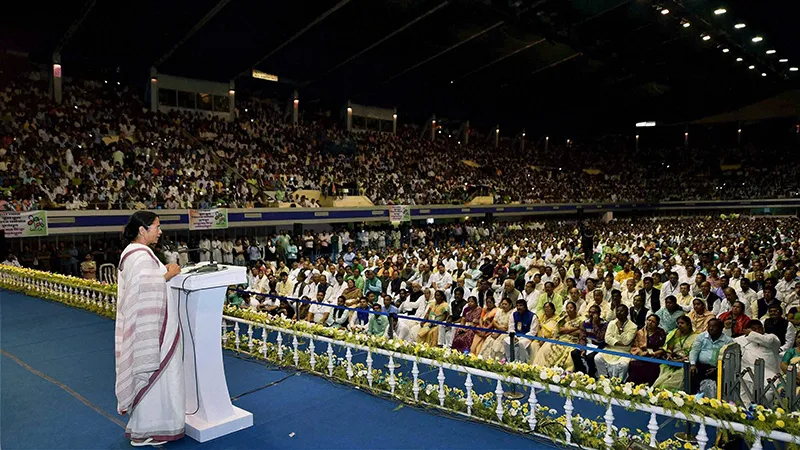As West Bengal approaches the assembly elections, the ruling All India Trinamool Congress seems to be sitting pretty. While much is being made in some quarters of the possibility of an alliance between the CPI(M), which ruled the state from 1977 to 2011, and the Congress, that is really an academic discussion.
Chief Minister Mamata Banerjee has reduced the CPI(M) to distant second place. The Congress, which was Banerjee’s ally in the 2011 election, represents a demography that is either ageing or confined to three districts, Murshidabad, Malda and North Dinajpur. The Congress’ ability to transfer votes remains in doubt. Many of its surviving voters have spent a lifetime opposing the CPI(M) and, other than for personality or factional reasons, would probably tilt towards the Trinamool anyway. As such, irrespective of whether the CPI(M) and the Congress come together or not, the Trinamool has reason to be confident.
The fourth party in the race is the BJP, which won an impressive 16% of the vote in the 2014 Lok Sabha election, but has since slipped in West Bengal. If anything, this would concern Banerjee, as the lower the BJP goes the smaller its ability to slice into the Opposition vote and leave the Trinamool comfortable. In a peculiar sense, the Trinamool will be cheering for the BJP to remain at a certain vote threshold.
Why is Banerjee winning? There are many reasons. First, she remains strong in south Bengal, building on her base in Kolkata and the neighbouring districts of North and South 24 Parganas. In 2011, the Trinamool had swept seats here, winning by massive margins. Even if it loses ground this year, it remains far ahead. In north Bengal, where traditionally the Congress and the CPI(M) have challenged each other, the Trinamool is still the rising force, with the new energy. Here, like in the south earlier, the CPI(M) edifice is crumbling. As for the Congress, it is only a rump.
Astute voter mobilisation has helped Banerjee. For instance, she has united the Muslim vote to telling effect. The Muslims comprise 27% of Bengal’s people and are believed to vote in higher numbers than the general population. The Muslim communities in the state fall into two broad categories. The Bengali-speaking Muslims, present in the rural peasantry, used to vote for the CPI(M). The Urdu-speaking Muslims, settled in Bengal but born to families that migrated from the north, were largely affiliated with the Congress. The Trinamool has drawn from both sections, though its method of wooing Muslim voters has often been crude.
Banerjee’s success, and the relative decline of the BJP since 2014, have led to a variety of superficial theories. There is the argument that Bengal has rejected ‘Hindu politics’, and the Trinamool is only benefiting from an atmosphere of harmony fostered by the CPI(M) in its 34 years in power. Absence of major religious riots in Bengal in the 1980s and early 1990s — when northern and western India saw regular outbreaks — is cited as evidence of this.
While not without substance, such contention has its limits. It is true that Bengal has for the most part escaped large-scale religious violence in recent decades — the odd turbulence in Malda notwithstanding — even if it has paradoxically been the location of brutal political violence. Even so, to equate the absence of religious riots, eminently desirable as that absence is, with the absence of denominational identities and such identity-based political mobilisation is naïve.
The truth is for decades the CPI(M) absorbed the Bengali nativist sentiment in its political persona and was in a manner of speaking the Hindu party in the state. The social character of the party, its hierarchy and its leadership would reflect that. So would its history. In the early decades after Independence, the Left parties were the spokespersons for East Pakistani refugee communities.
Take an example. In January 1964, riots broke out in Kolkata as a response to ferocious anti-Hindu mobilisation in East Pakistan. That violence, in turn, had occurred after the disappearance of the holy relic in Hazratbal, Srinagar, in December 1963. Left-wing parties in Bengal were at the forefront of the ‘Hindu’ cause. At a post-riots ‘citizens’ convention’ in Kolkata Jyoti Basu (then of the CPI) shared space with the Forward Bloc, the Jana Sangh and even something called the Bolshevik Party. The convention expressed anguish at the plight of Hindus in East Pakistan.
All that may seem dated today, but the fact is in its years in power the CPI(M) did sublimate Bengali Hindu instincts into nativist and regional identity and a notion of supposedly progressive politics. In parallel, it built a constituency in the rural peasantry, both Hindu and Muslim, on the basis on tenancy rights. With the collapse of that social coalition, the CPI(M) has declined. A section of the party’s support has migrated to the Trinamool and a trickle to the BJP. A restless middle is still looking for an outlet.
Given this, there remains space for a nativist party in Bengal that can inherit the social character of the old CPI(M) but with a more modern economic agenda. Such a party can fill the Opposition vacuum that has emerged in Bengal and lay the foundations of a rival to the Trinamool, maybe not in 2016 but in a future election.
Can the BJP be that Bengali nativist party? Well, frankly, there is room in the state for a Bengali party with a Hindu tendency, rather than for a Hindu party with a Bengali tendency. As such, the BJP in Bengal will have to adapt itself to local idioms, textures and faces. Between 2014 and now, it has not quite done so.
This commentary originally appeared in The Hindustan Times.
The views expressed above belong to the author(s). ORF research and analyses now available on Telegram! Click here to access our curated content — blogs, longforms and interviews.




 PREV
PREV


